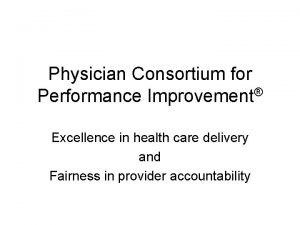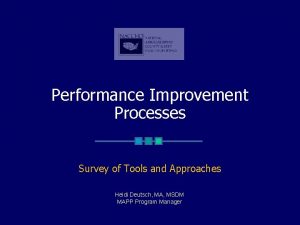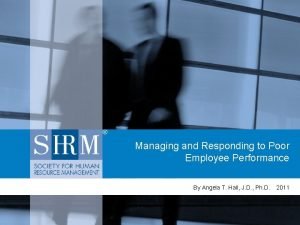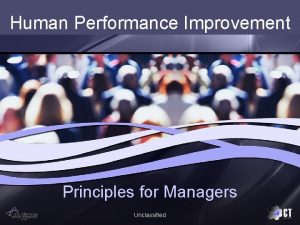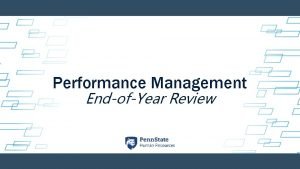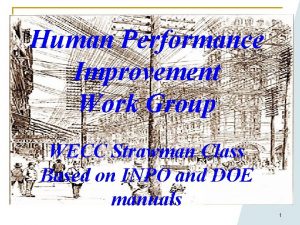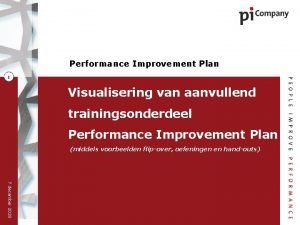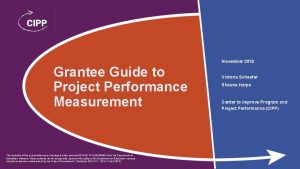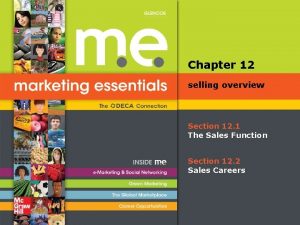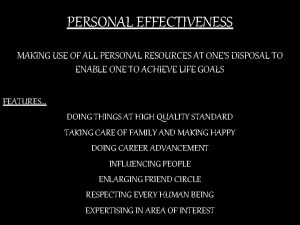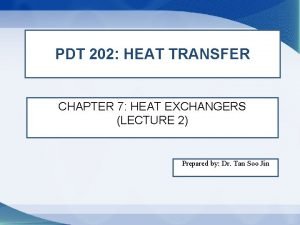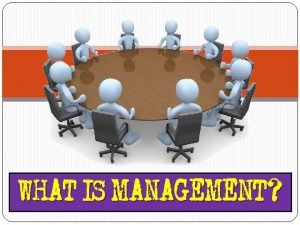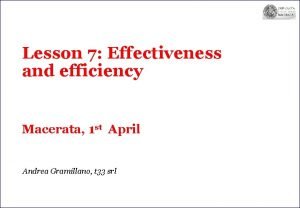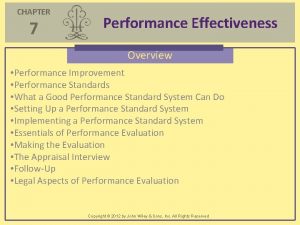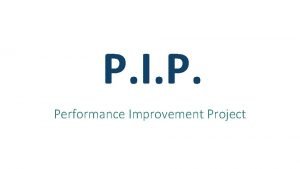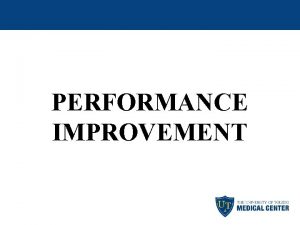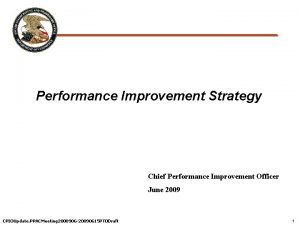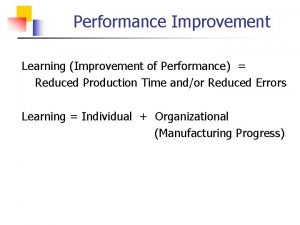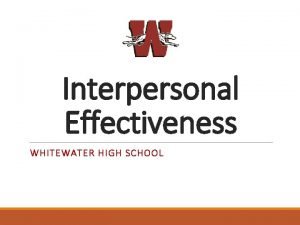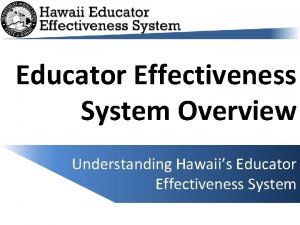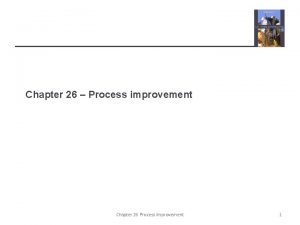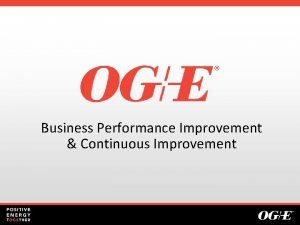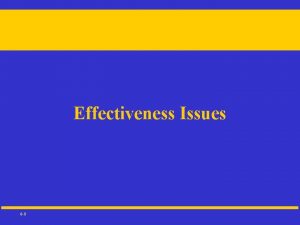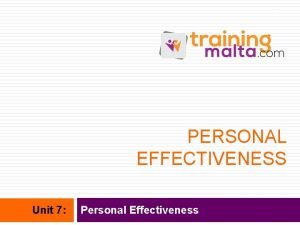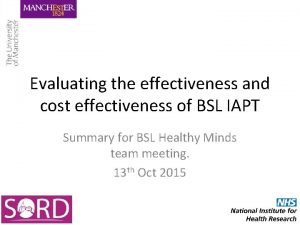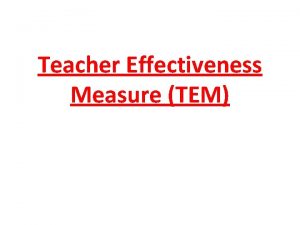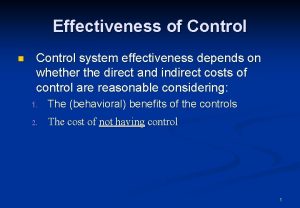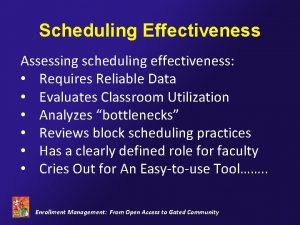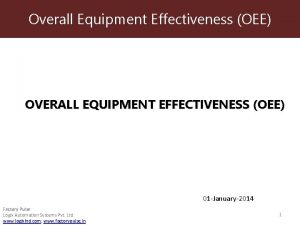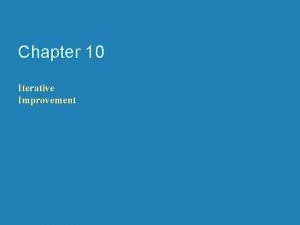CHAPTER 7 Performance Effectiveness Overview Performance Improvement Performance

































- Slides: 33

CHAPTER 7 Performance Effectiveness Overview • Performance Improvement • Performance Standards • What a Good Performance Standard System Can Do • Setting Up a Performance Standard System • Implementing a Performance Standard System • Essentials of Performance Evaluation • Making the Evaluation • The Appraisal Interview • Follow-Up • Legal Aspects of Performance Evaluation Copyright © 2016 by John Wiley & Sons, Inc. All Rights Reserved

CHAPTER 7 Performance Effectiveness Performance Improvement • Performance improvement operates on the premise that to be effective, individuals and teams require the following: • Direction about what the organization wants to accomplish • Clear expectations • The equipment to do the job • Information and incentives to keep them on track Copyright © 2016 by John Wiley & Sons, Inc. All Rights Reserved

CHAPTER 7 Performance Effectiveness Performance Standards • Each performance standard states 3 things about each unit of the job: • • • What the employee is to do. How it is to be done. To what extent it is to be done (how much, how well, how soon). • Job descriptions are often used in recruiting, evaluating applicants, & training. • They are also useful in assigning work, evaluating performance, & deciding on disciplinary action. Copyright © 2016 by John Wiley & Sons, Inc. All Rights Reserved

CHAPTER 7 Performance Effectiveness Figure 7. 1 Anatomy of a performance standard. Copyright © 2016 by John Wiley & Sons, Inc. All Rights Reserved

CHAPTER 7 Performance Effectiveness What a Good Performance Standard System Can Do • If you develop a full set of performance standards for each job classification you: • have the basis for a management system for your people & the work they do. • can use them to describe the jobs, to define the day’s work for each job, & to train employee’s. • can use them as a basis for rewarding achievement. • can use them as diagnostic tools to pinpoint ineffective performance. • can use them in disciplining workers. Copyright © 2016 by John Wiley & Sons, Inc. All Rights Reserved

CHAPTER 7 Performance Effectiveness Performance Standards: In Recruiting & Hiring • Defines the job. • Aids in planning & forecasting. • Provides a method of testing skills. • Defines a day’s work. Copyright © 2016 by John Wiley & Sons, Inc. All Rights Reserved

CHAPTER 7 Performance Effectiveness Performance Standards: In Training & Evaluating Performance • Provides blueprints for a training program. • Sets a competency standard for job performance. • Provides an objective evaluation method. • Pinpoints needs for improvement. • Identifies superior workers. Copyright © 2016 by John Wiley & Sons, Inc. All Rights Reserved

CHAPTER 7 Performance Effectiveness Performance Standards: In Your Job & Career • Helps you to develop managerial skills. • Reduces crisis management. • Provides time for true management. Copyright © 2016 by John Wiley & Sons, Inc. All Rights Reserved

CHAPTER 7 Performance Effectiveness Setting Up a Performance Standard System • In setting up a performance standard system, there are three essentials for success: • Employee participation: better results, commitment, & morale. • Active supervisory leadership & assistance throughout: be in charge at all times but, work together. • Built in reward system: rewards linked to how well each worker meets the performance standards. Copyright © 2016 by John Wiley & Sons, Inc. All Rights Reserved

CHAPTER 7 Performance Effectiveness Defining the Purpose • The first step is to define the purpose for which standards will be used. • This should define a day’s work, set standards, develop training programs, & evaluate on the job performance. Copyright © 2016 by John Wiley & Sons, Inc. All Rights Reserved

CHAPTER 7 Performance Effectiveness Analyzing the Job • The next step is to analyze the job & break it down into units. • You & your employees identify units of work that are performed. • List in order of performance all the tasks or steps to be taken in completing that unit of work. • Sometimes it is appropriate to define the 3 levels of performance: • • • Optimistic Realistic Minimum Copyright © 2016 by John Wiley & Sons, Inc. All Rights Reserved

CHAPTER 7 Performance Effectiveness Writing the Performance Standards 1. 2. 3. 4. 5. Be specific, clear, complete, & accurate. Be measurable & observable. Be attainable. Conform to company policies, goals, legal & moral restraints. Certain kinds of standards must have time limits set for achievement. Copyright © 2016 by John Wiley & Sons, Inc. All Rights Reserved

CHAPTER 7 Performance Effectiveness Developing Standard Procedures • The next step is to develop standard procedures. • These state what a person must do to achieve the results, they give spelled out instructions for the action. • Functions: • To standardize procedures you want followed. • To provide a basis for training. • Areas of caution: • Do not get carried away on detail. • Do not make rigid rules when there is a choice on ho things can be done. Copyright © 2016 by John Wiley & Sons, Inc. All Rights Reserved

CHAPTER 7 Performance Effectiveness Training Associates to Meet Performance Standards • A training program should have a training objective for each standard. • Training objective: a trainer's’ goal: • a statement, in performance terms, of the behavior that shows when training is complete. Copyright © 2016 by John Wiley & Sons, Inc. All Rights Reserved

CHAPTER 7 Performance Effectiveness Evaluating On-the-Job Performance • The final step in developing a performance standard system is to evaluate worker performance on the job using the performance standards that apply to that job. • The first evaluation is a test of both the workers & the system. • If the workers meets all the standards- rewards are in order. • This also indicates that standards & procedures are suitable & workable. Copyright © 2016 by John Wiley & Sons, Inc. All Rights Reserved

CHAPTER 7 Performance Effectiveness Implementing a Performance Standards System Keys to making it work: 1. 2. 3. 4. 5. Workers’ cooperation in developmental stage. Put the system to work slowly over a period of time. An award or incentive system. Recognition & use of workers potential. Periodic review. Copyright © 2016 by John Wiley & Sons, Inc. All Rights Reserved

CHAPTER 7 Performance Effectiveness How a Performance Standards System Can Fail • The standards are not clearly stated & communicated. • The supervisor changes standards without telling employees. • The supervisor neglects various follow up elements. • Employees find no challenges or rewards in the system. • The supervisor becomes too preoccupied with maintaining the system. • The system is administered in a negative way. Copyright © 2016 by John Wiley & Sons, Inc. All Rights Reserved

CHAPTER 7 Performance Effectiveness Essentials of Performance Evaluation • Performance evaluation: • A periodic review & assessment of each employee’s performance during a given period. • Are not always used for hourly workers in the hospitality industry (lack of time, workers do not stay long enough, etc. ). • Does not substitute in any way a informal evaluation. Copyright © 2016 by John Wiley & Sons, Inc. All Rights Reserved

CHAPTER 7 Performance Effectiveness Purpose and Benefits Five good reasons or purposes of a performance review: 1. In your day-to-day evaluations you tend to concentrate on the people who need to improve. 2. Looking back over a period of time gives you a different perspective. 3. A performance review is for the record. 4. It lets people know how well they are doing. 5. A performance review not only looks backward, it looks ahead. Copyright © 2016 by John Wiley & Sons, Inc. All Rights Reserved

CHAPTER 7 Performance Effectiveness Purpose and Benefits • Performance reviews have many uses beyond their primary concern with evaluating and improving performance. • One is to act as the basis for an employee’s salary increase. • Another use is to identify workers with potential for advancement. • Other managers may use your performance reviews. • Your boss, to rate your own performance as a supervisor, may use your performance reviews. • Performance reviews can provide feedback on your hiring and training procedures. • Finally, performance reviews provide the occasion for supervisors to get feedback from employees about how they feel about their job, the company, and the way they are treated. Copyright © 2016 by John Wiley & Sons, Inc. All Rights Reserved

CHAPTER 7 Performance Effectiveness Steps in the Process 1. 2. 3. 4. Prepare for the evaluation. Making the evaluation. Sharing it with the worker. Providing a follow up. Copyright © 2016 by John Wiley & Sons, Inc. All Rights Reserved

CHAPTER 7 Performance Effectiveness Making the Evaluation • Evaluations are typically formalized in an evaluation form. • This form lists performance dimensions or categories in measurable or observable terms. • Dimensions should be related to the job, & clearly defined in objective & observable terms. Copyright © 2016 by John Wiley & Sons, Inc. All Rights Reserved

CHAPTER 7 Performance Effectiveness Standards and Ratings • There should be measurable or observable standards, wherever possible to make evaluation more objective. • Many evaluation forms use a rating scale ranging from outstanding to unsatisfactory performance. • A common scale includes ratings of outstanding, above average, needs improvement, & poor. • The major problem with ratings such as outstanding or excellent is figuring out what they mean in performance terms. • The more precise these descriptions are, the fairer & more objective the ratings will be (i. e. point values). • No evaluation form solves all the problems of fairness & objectivity. Copyright © 2016 by John Wiley & Sons, Inc. All Rights Reserved

CHAPTER 7 Performance Effectiveness Pitfalls in Rating Employee Performance • The Form itself • Halo effect • Letting feeling bias judgment • Comparing one person to another • Supervisors feelings about evaluation process affects ratings • Concern about consequences • Procrastination • Supervisor gives ratings for the effect they will have • Rating employees on most recent performance Copyright © 2016 by John Wiley & Sons, Inc. All Rights Reserved

CHAPTER 7 Performance Effectiveness Defense Against Pitfalls • Evaluate performance, not the employee. • Give specific examples. • Where there is substandard performance ask WHY? • Use the rule of finger. • Think fair & consistent. • Get others input. • Write down ideas & discuss with the employee how to improve performance. Copyright © 2016 by John Wiley & Sons, Inc. All Rights Reserved

CHAPTER 7 Performance Effectiveness Employee Self-Appraisal • Employees evaluate themselves. • May result in less employee defensiveness. • May result in a more constructive performance appraisal interview. • May improve motivation & job performance. Copyright © 2016 by John Wiley & Sons, Inc. All Rights Reserved

CHAPTER 7 Performance Effectiveness The Appraisal Interview • A private face to face session between you & your employee. • Plan: • Pick a place free of interruption at an appropriate time, review the evaluation, & keep in mind your goal of a positive climate of communication & problem solving. Copyright © 2016 by John Wiley & Sons, Inc. All Rights Reserved

CHAPTER 7 Performance Effectiveness Planning the Interview • Each interview should take place in a quiet area free of interruption. • It is important to review your written evaluation shortly before the interview and to plan how you will communicate it to the employee for best effect. • Your major goal for the interview is to establish and maintain a calm and positive climate of communication and problem solving rather than a negative climate of criticism or reprimand. Copyright © 2016 by John Wiley & Sons, Inc. All Rights Reserved

CHAPTER 7 Performance Effectiveness Conducting the Interview • Start off with small talk. • Make sure the employee understands the evaluation process. • Ask the employee to rate their performance. • Encourage the employee to comment on your judgments. • Get the employee to do most of the talking. • Work with them on setting improvement objectives. • Summarize the interview, end on a positive note. Copyright © 2016 by John Wiley & Sons, Inc. All Rights Reserved

CHAPTER 7 Performance Effectiveness Common Mistakes in Appraisal Interviews • Authoritarian approach • Tell & sell approach • Criticizing & dwelling on past mistakes • Failing to listen-arguing- interrupting • Losing control- letting emotions take over • Reducing standards for one person Copyright © 2016 by John Wiley & Sons, Inc. All Rights Reserved

CHAPTER 7 Performance Effectiveness Follow-Up • 1 st see that people receive the rewards they have coming to them. • For people you have discovered need more training, arrange to provide it for them. • For people you feel will improve themselves, follow their progress discreetly. • There will be people who you are sure will make no attempt to improve, who will continue to get by with minimum performance, reassess them in your mind. • There are 2 important facets of follow-up. • Actually carrying it out. • Use all you have discovered about your people & yourself to improve your working relationship with each person you supervise. Copyright © 2016 by John Wiley & Sons, Inc. All Rights Reserved

CHAPTER 7 Performance Effectiveness Legal Aspects of Performance Evaluations • EEO laws effecting performance evaluation include: • Title VII of the Civil Rights Act • Equal Pay Act • Age Discrimination in Employment Act • Americans with Disabilities Act Copyright © 2016 by John Wiley & Sons, Inc. All Rights Reserved

CHAPTER 7 Performance Effectiveness Fair and Legal Evaluations 1. Evaluations should be based on standards obtained from job analysis. 2. Use objective, observable, & measurable performance standards. 3. Keep a positive rapport during the interview. 4. Do not discuss qualities of employee based on a membership of a group. 5. Document frequently. 6. Employees should be given a way to appeal. Copyright © 2016 by John Wiley & Sons, Inc. All Rights Reserved
 Stronge leader effectiveness performance evaluation model
Stronge leader effectiveness performance evaluation model Performance improvement plan examples
Performance improvement plan examples Physician consortium for performance improvement
Physician consortium for performance improvement Performance improvement survey
Performance improvement survey Shrm pip template
Shrm pip template Human performance improvement principles
Human performance improvement principles Housekeeping items for meetings
Housekeeping items for meetings Questioning attitude human performance
Questioning attitude human performance Loopbaandadvies
Loopbaandadvies Call center performance improvement plan template
Call center performance improvement plan template A 23 year old male experienced severe head trauma
A 23 year old male experienced severe head trauma Emt chapter 14 medical overview
Emt chapter 14 medical overview Chapter 9 lesson 2 photosynthesis an overview
Chapter 9 lesson 2 photosynthesis an overview Chapter 12 selling overview
Chapter 12 selling overview Chapter 2 an overview of the financial system
Chapter 2 an overview of the financial system Chapter 1 overview of verb tenses
Chapter 1 overview of verb tenses Overview of personal finance chapter 1
Overview of personal finance chapter 1 Overview of the dentitions chapter 11
Overview of the dentitions chapter 11 Introduction to personal finance chapter 1 answers
Introduction to personal finance chapter 1 answers Chapter 32 an overview of animal diversity
Chapter 32 an overview of animal diversity Chapter 1 an overview of financial management
Chapter 1 an overview of financial management Elements and their properties section 1 metals
Elements and their properties section 1 metals Chapter 1 overview of financial statement analysis
Chapter 1 overview of financial statement analysis External forms of social control criminology
External forms of social control criminology The effectiveness of online and blended learning
The effectiveness of online and blended learning Steiner's model of actual productivity
Steiner's model of actual productivity It is making use of all personal resources
It is making use of all personal resources Ntu heat transfer
Ntu heat transfer It is an arrangement of people in organization
It is an arrangement of people in organization Efficiency and effectiveness examples
Efficiency and effectiveness examples Cath lab cost effectiveness
Cath lab cost effectiveness Liberal reforms essay
Liberal reforms essay Efficiency and effectiveness examples
Efficiency and effectiveness examples Ntu in heat exchanger
Ntu in heat exchanger


